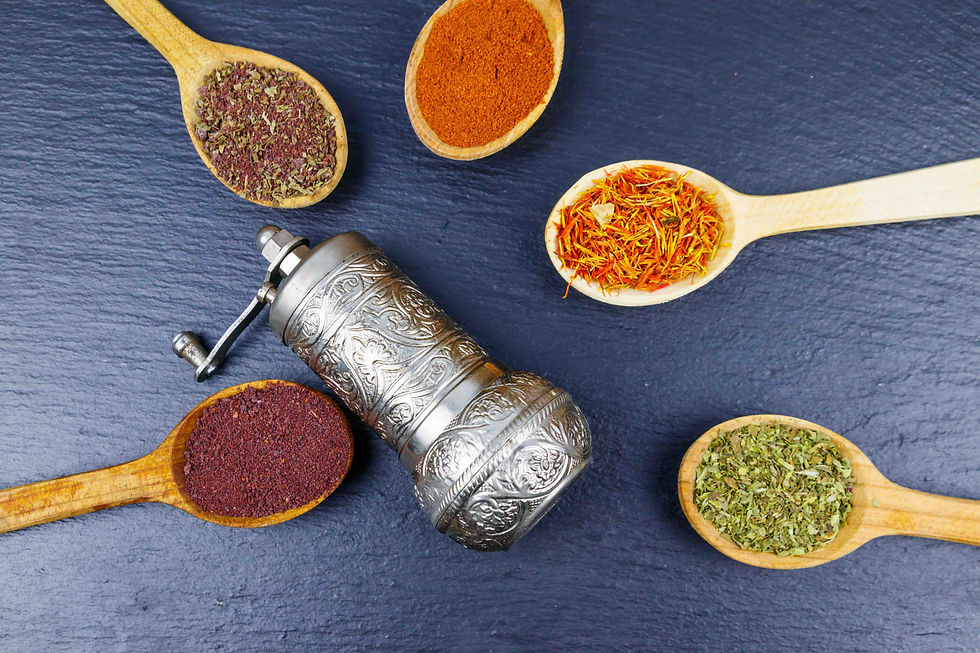Ras El Hanout رأس الحانوت
- Schatzi

- Mar 25, 2023
- 2 min read
Updated: May 11, 2023

Journey through the tantalizing world of North African flavors by making your own Ras El Hanout spice blend. Steeped in centuries of rich cultural history, this blend is as much a story as a seasoning. The name, which means "head of the shop," harkens to the fact that the blend is often made up of the best spices the seller has to offer. The warm, aromatic blend is perfect for adding depth and complexity to tagines, couscous, and stews. Take the time to create your own blend, and you'll be rewarded with a vivid and truly authentic taste of North Africa.
I learned about this spice mixture during my travels in Morocco. After enjoying Lamb Tajine many times, I noticed a difference in each taste. Although the ingredients can vary, they are most of the time similar. It had to be the spice that gave this traditional dish a different flavor every time.
Beside of what I have learned in Morocco, I researched this spice mixture on the Internet, and I came across many different versions with various ingredients. All of them were labeled "authentic." Reasons for this great variety are different geographical regions, availability of ingredients, and preferences, handed down from generation to generation within a family. Ras El Hanout can be made with just five or up to forty (!) ingredients, depending on whom you ask. Here is a quick overview of six different sources I have found on the Internet:

Analyzing the above list, I found a minimum (must-have) of 10 ingredients to start with: Cumin, Ginger, Black Pepper, Cinnamon, Coriander Seeds, Cayenne Pepper, Allspice, Cloves, Turmeric, and Nutmeg.
I will use my version of Ras El Hanout for a Lamb Tajine. Therefore, I picked the specific ingredients. However, I encourage you to experiment and add your favorite flavors to your version of Ras El Hanout. Let me know in the comments what you created.

Of course, you can always buy an already prepared Ras El Hanout in some stores or online. But you will miss out on learning how these flavors come together and change the outcome of your final recipe. Give it a try and travel for a moment to a Morrocan kitchen, experiencing the exciting food culture of North Africa.
Ingredients
1 tbsp Ground Cumin
1 tbsp Ground Ginger
1 tbsp Ground Coriander
1 tbsp Ground Turmeric
2 tsp Red Chili Powder
2 tsp Sweet Paprika
2 tsp Ground Cinnamon
2 tsp Ground Allspice
2 tsp Ground Black Pepper
1 1/2 tsp Ground Mace
1 1/2 tsp Ground Nutmeg
1 1/2 tsp Ground Cardamom
1 tsp Fennel Seed
1/2 tsp Ground Cloves
1/2 tsp Cayenne Pepper
Optional:
(These ingredients will deliver a more floral aroma and taste.)
2 Bay Leaves
1 tsp Dried Lavender
1 tbsp Dried Rose Petals The above three ingredients must be ground in a spice mill and then strained through a fine mesh sieve. You will receive less once they are ground which is enough.
1/2 tsp Ground Fenugreek
1 1/2 tsp Ground Orris Root
The process

If you prefer to buy the whole spices, not ground (that is what I do), grind them in a spice grinder.
Mix all ground ingredients in a bowl.
Store the Ras El Hanout in a closed-lid, air-tight container in a dark, dry place for up to two years. You will notice fewer flavors after six months.




Comments